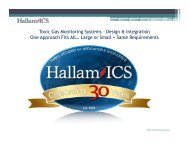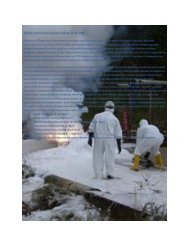SESHA 2011 Program Book - Semiconductor Safety Association
SESHA 2011 Program Book - Semiconductor Safety Association
SESHA 2011 Program Book - Semiconductor Safety Association
Create successful ePaper yourself
Turn your PDF publications into a flip-book with our unique Google optimized e-Paper software.
Tuesday<br />
8:00-9:30 am<br />
Opening Ceremony and<br />
Awards Presentation<br />
Sonora A/B/C<br />
10:00-11:00 am<br />
SIA Regional Updates<br />
Sonora A/B/C<br />
11:00 am-Noon<br />
Keynote - Global <strong>Semiconductor</strong><br />
Industry - Looking Forward<br />
Sonora A/B/C<br />
Noon-1:45 pm<br />
Final <strong>Program</strong><br />
Lunch Break, Exhibit Hall<br />
1:45-4:30 pm<br />
Global Chemical Regulations<br />
Sonora A<br />
1:45 pm Environmental Regulatory Developments<br />
in the EU<br />
Harte, S; ESIA - European <strong>Semiconductor</strong> Industry <strong>Association</strong>,<br />
Belgium<br />
ISESH <strong>2011</strong> / <strong>SESHA</strong> 33rd Annual ESH Symposium<br />
Abstract Title : Environmental Regulatory Developments<br />
in the European Union Substance restrictions<br />
or substance related bans on use are an obvious point of<br />
concern for many sections of the high tech sector. They<br />
are however not something new for the worldwide semiconductor<br />
manufacturing supply chain. Nevertheless the<br />
restriction of substances whether through EU RoHS or<br />
REACH systems will continue into the forseeable future.<br />
In addition the industry needs to prepare activity<br />
and roadmap plans to move away from the exempted<br />
substance and applications where possible to do so.<br />
This presentation will be broad ranging in nature and<br />
aim to update the conference on the regulatory developments<br />
in Europe in terms of substances restrictions<br />
through REACH, EU RoHS or potentially PFOA and<br />
the evolution of potential revised flourinated gas regulations<br />
within the EU in <strong>2011</strong> and will assess the impact<br />
on semiconductor industries. The presentation will also<br />
outline the revised exemption review systems under the<br />
revised RoHS directive.<br />
7<br />
2:30 pm JAMP Activity Update<br />
Ibuka, S; Tokyo Electron Limited<br />
JAMP means “Joint Article Management Promotion”<br />
council for cross-industry. JAMP frmawork is<br />
applicable to chemical/subsatance information transfer<br />
through whole supply chain globally, which are required<br />
by EU REACH, EU CLP, each country’s GHS,<br />
US TSCA or many international/local legslation. JAMP<br />
was introduced at the last IHTESH held in Taiwan. Currently,<br />
JAMP is introduced in ISO26000 and the draft of<br />
ECHA REACH guidance. JAMP activity update should<br />
be presented there.<br />
3:15 pm Break & Raffle Distribution, Exhibit Hall<br />
3:45 pm Decontamination and Decommissioning<br />
of Equipment: Roundtable Discussion<br />
Yeakley, T; Texas Instrumentsu<br />
<strong>Semiconductor</strong> manufacturing and research facilities<br />
regularly ship equipment parts for rebuild or repair.<br />
These parts could contain chemical and byproducts residues<br />
that cannot be removed on-site without causing<br />
irreversible damage to the part. The presence of these<br />
residues may also require compliance with various regulations<br />
during transport from DOT, IATA, IMDG, etc.<br />
The purpose of this roundtable discussion is to share<br />
information between semiconductor companies on the<br />
best known methods to classify these parts for transportation.<br />
We will discuss how to determine whether decontamination<br />
of a specific part onsite is appropriate; the<br />
de-minimus quantities above which the part will have to<br />
be regulated; methods used to determine the hazards of<br />
byproducts in parts; necessity of testing the byproducts;<br />
whether regulatory tests can be modified for practical<br />
application; and methods for managing special cases<br />
like batteries and magnets.<br />
1:45-5:15 pm<br />
<strong>Safety</strong>-IH<br />
Sonora B<br />
1:45 pm Evaluation of Potential Cytotoxicity of<br />
Nanoscale Inorganic Oxides Utilized in <strong>Semiconductor</strong><br />
Manufacturing<br />
Sierra-Alvarez, R, Otero, L, Garcia, C, Luna-Velasco, A,<br />
Cobo, A, Field, JA; University of Arizona, Tucson<br />
The future success of the semiconductor industry<br />
is dependent on the capacity to manufacture smaller<br />
and smaller devices which requires the use of nanopar-




